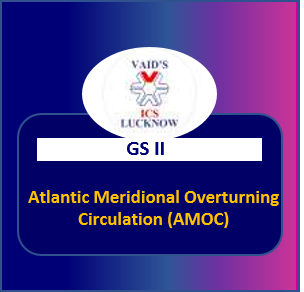CURRENT AFFAIRS
Get the most updated and recent current affair content on Padhaikaro.com
Atlantic Meridional Overturning Circulation (AMOC)
- Vaid's ICS, Lucknow
- 11, Aug 2021

Why in News?
A study published in Nature Climate Change has noted that Atlantic Meridional Overturning Circulation (AMOC) is losing its stability.
What is Atlantic Meridional Overturning Circulation (AMOC)?
- The AMOC is a large system of ocean currents.
- It is the Atlantic branch of the ocean conveyor belt or Thermohaline circulation (THC).
- THC is a part of the large-scale ocean circulation that is driven by global density gradients created by surface heat and freshwater fluxes.
- AMOC distributes heat and nutrients throughout the world’s ocean basins.
- It carries warm surface waters from the tropics towards the Northern Hemisphere, where it cools and sinks.
Why is the AMOC slowing down?
Global warming
- Climate models have long predicted that global warming can cause a weakening of the major ocean systems of the world.
- Recently, researchers noted that a part of the Arctic’s ice called “Last Ice Area” has also melted.
- The freshwater from the melting ice reduces the salinity and density of the water. All these changes make the ocean water lighter and so reduce the sinking in the ‘conveyor belt’, leading to a weaker AMOC.
- If we continue to drive global warming, the Gulf Stream System will weaken further – by 34 to 45 per cent by 2100.
- This could bring us dangerously close to the tipping point at which the flow becomes unstable.
Role of Indian Ocean:
- A 2019 study suggested that the Indian Ocean may also be helping the slowing down of AMOC.
- As the Indian Ocean warms faster, it generates additional precipitation and with so much precipitation in the Indian Ocean, there will be less precipitation in the Atlantic Ocean, leading to higher salinity in the waters of the tropical portion of the Atlantic.
- This saltier water in the Atlantic, as it comes north via AMOC, will get cold much quicker than usual and sink faster.
- This would act as a jump start for AMOC, intensifying the circulation
Facts For Prelims:
The Pradhan Mantri Ujjwala Yojana (PMUY):
- Prime Minister Narendra Modi launched the second phase of the Pradhan Mantri Ujjwala Yojana (PMUY).
Key Points
- It is a scheme of the Ministry of Petroleum & Natural Gas for providing LPG connections to women from Below Poverty Line (BPL) households. It was launched in 2016.
- During Ujjwala 1.0, a target was set to provide LPG connections to 5 crore women members of BPL households.
- Subsequently, the scheme was expanded in April 2018 to include women beneficiaries from seven more categories (SC/ST, PMAY, AAY, Most backward classes, tea garden, forest dwellers, Islands).
- Also, the target was revised to 8 Crore LPG connections.
- This target was achieved in August 2019, seven months ahead of the target date.
PMUY 2.0:
- In the Union budget for FY 21-22, provision for an additional one crore LPG connection under the PMUY scheme was announced.
- These one crore additional PMUY connections (under Ujjwala 2.0) aim to provide deposit-free LPG connections to those low-income families who could not be covered under the earlier phase of PMUY.
Dragon fruit:
Dragon fruit grown by farmers from Gujarat and West Bengal has been exported to the United Kingdom and Bahrain for the first time.
- Dragon fruit, also known as Kamalam in India, is a tropical fruit belonging to the family Cactaceae.
- It is originally a species of Central America.
- It is rich in fiber, vitamins, minerals and antioxidants.
- There are three main types – pink peel with white pulp, pink peel with red pulp and yellow peel fruit with white pulp.